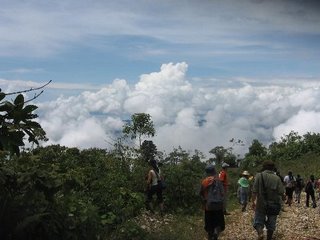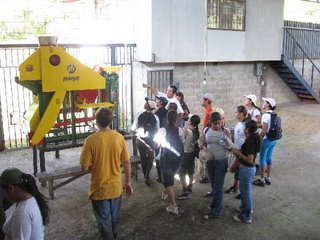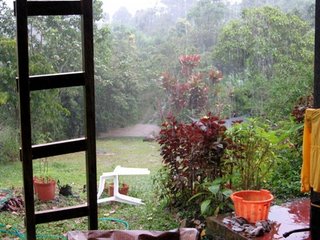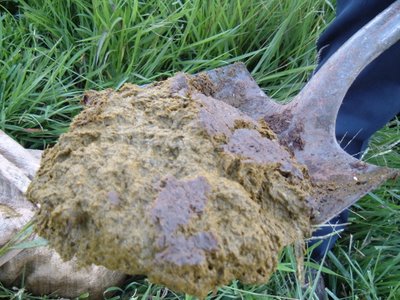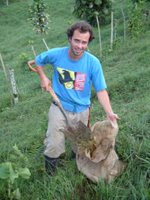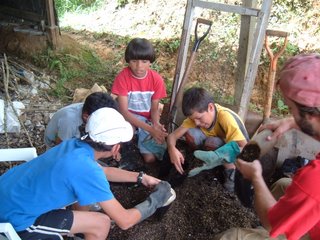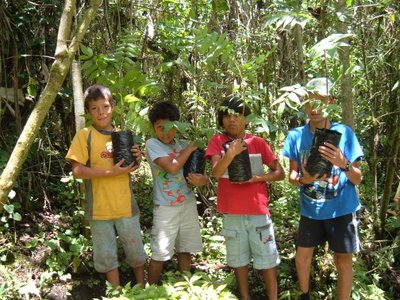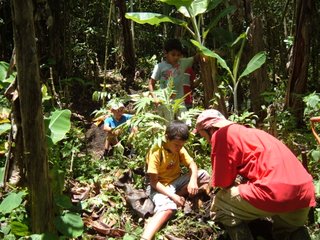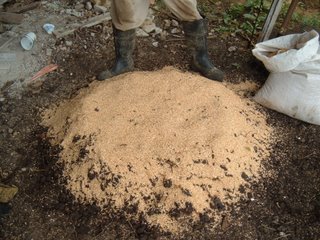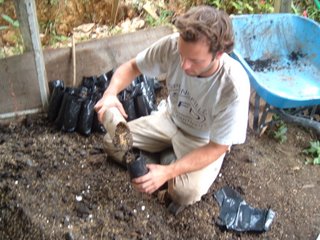
This was the first year of Finca Project. We have accomplished a lot, and we want to thank all of you who helped make this year such a success through your generous donations, hard work, and creative ideas. I just want to take this blog to review what has been going on.
2006
January
-Eliot and Brendan return from Egypt .
-Eliot, Brendan and Jeff have a two-day long brainstorming session in Santa Cruz with help from some of our parents to strategize how this next year would work.
-We had a fundraising party in Austin raising $1,800 two days before Brendan and Eliot flew down to Costa Rica. Wow, have we come a long way from that party when we could only speak vaguely about what we planned on doing!

Eliot and Brendan at the Fundraiser in Austin last January.
February
-Started reconstruction of our farmhouse.
-Worked with a CAN intern, Nicole, on her project of methane-biogas conversion to electricity.
-Aided Dr Catherine Lindell to net and tag migratory birds.

The house before....
March
-Finished farmhouse reconstruction and moved onto the farm.
-Took first trip to rainforest (Las Alturas) to collect seeds, collecting over 10,000.
-Met with the coffee cooperative, CoopePueblos, to plan our first joint reforestation project.
-Brendan flew back to the US.

After... (Those are boxers drying not Tibetan prayer flags.)

This is the rainforest where we collect our seeds.
April
-Started our seedling nursery.
-Jeff and Robin's baby girl, Ayla, is born.
-Eliot visits Nicaraguan coffee farmers with members of CoopePueblos to learn about the differences between Nicaragua and Costa Rica.

A School in La Corona Nicaragua.

The beginnings of our nursery.
May
-Our first volunteers, Mikael Dooha and Takashi Iwahashi, live and work with us.
-We take second trip to Las Alturas to collect more seeds.
-Expand our seedling nursery.

Eliot takes the volunteers on a tour of our farm.
June
-Eliot returns to US.
-We hire our neighbor, Harold, to continue collecting seeds and expanding the nursery.

Our neighbor Harlod, and his family. In the next year we plan to hire Harold full-time, if we have enough funding.
July
-Eliot returns to Costa Rica.
-Starts English classes with Peace Corps volunteers, Jacob and Trina.
-Starts collecting oak seeds (acorns) for the nursery.
-Begins organic vegetable garden.
-Works with Evergreen intern, Natasha, on charcoal composting methods.

Eliot teaching English.
August
-Eliot is invited to judge an English competition at the local high school.
-Brendan returns to Costa Rica, Eliot to the US.
-Brendan continues English Classes.
-Works with Santa Cruz intern, Dan, on earthworm compost.
-Brendan begins reforestation projects at local elementary school.

Brendan planting trees with the local elementary school.

Dan conducting research on our seedlings.
September
-Brendan visits Panama to learn about Panamanian reforestation projects.
-Eliot returns to Costa Rica.
-We start working with the local high school, the Association of Development, and CoopePueblos to create an ecological student group - "Jovenes Ecologicos".
-Continue with English classes.
-Planted over 300 trees at Aguabuena High School.


Students brainstorming the steps involved
in a reforestation project.
October
-We take "Jovenes Ecologicos" on many field trips.
-Met with the Association of Development, CoopePueblos, and some governmental agencies to solidly our first reforestation project along the Rio Salto.
-Expanded English classes
-Eliot and Brendan return to US for Finca Tour 2006.

Field trip to the Rio Salto.
November
-Eliot guests lectures at a few high schools in Austin.
-Brendan screens Birdsong and Coffee (a documentary) in Illinois.
-We networked with universities to create internship programs, Princeton asks us to reserve two spots for their students every year.
December
-Finca Tour 2006 raises over $5000.
-We screened Birdsong and Coffee in Austin with the help Bob and Burgess of the Travis Audubon Society to a very receptive crowd.
-Brendan returns to Costa Rica.

Brendan at our Berkeley Fundraiser on December 2nd.
Next year.....
We are starting our High School Cultural Exchange Program where students from around the world will work together on our reforestation project in the Rio Salto. Between January and March (the dry season), we will be planning the project, working with high school students, college interns and community members to strategize around the difficulties we face. We will begin planting in May. Stay tuned for more....we are going to start a Video Blog to keep you more entertained.
Muchas gracias a todos.








